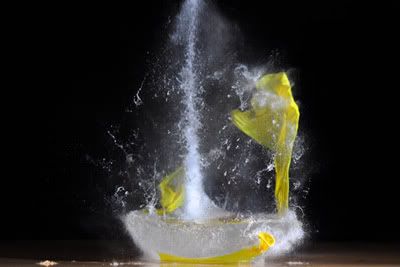I recently decided to try and make a cheap version of the sound activated flash trigger.
I got hold of an Arduino sound switch, readily available for around $2 on Amazon.
The sound switch has 3 pins which makes it really easy to wire up. At the bottom is the voltage input wire[VCC] , allowing from 3-5 volts, then the "ground" [GND]pin in the middle and the "out" [switch] pin.
I used a 3 way battery holder which provides 4,5 volts when 3 AA batteries are fitted. I used a fairly short pc cable and would advise making it much longer for a practical sound switch so you can move the flash around easily.
It's relatively simple to wire up. Obviously your red wire from the power supply goes to "VCC" and the black ground wire goes to GND. The only tricky part is connecting the pc wires to the circuit. Plug a pc cable into your flash with the two wires bared back. Connect a volt meter to measure the trigger voltage of your flash. If your flash doesn't have a pc port you can buy a pc hotshoe adapter.
For older flashes you can also have a look at Botzilla for a list of flash trigger voltages. If the trigger voltage is too high you will fry the circuit. Most modern flashes will work fine with it. Another option is to use it to trigger a wireless flash device so the flash is not connected directly to the circuit.
Have a look at the folowing image and take note of the colour of the leads from my meter and the colour of the wires from the pc plug connected to my SB26. I have 4,29 volts at the pc wires but my red lead is connected to the white wire and my black lead to the red wire - in this case perhaps it is the result of buying cheap pc cables because it appears that red is my ground and white is my positive feed.
So once you have established which is your positive wire from the pc plug, white in this case, solder that to the "out" [switched] pin. If you put them the wrong way around don't worry too much about it, it simply won't switch and will keep the green trigger light on on the circuit board, then you can just swap them around to get it right.
I have had this system running for two days and driven the guys at work crazy with it - so I know it will last. I had it connected to my SB26 on 1/64th power and tested the sensitivity adjustment [little grey '+' screw in the middle of the blue box] all the way down to the point where simply talking set the flash off. Turn it counter-clockwise and it gets more sensitive, to the point where it stays on. Turn it clockwise and it will get to the stage where you will need a really loud noise to make it switch.
One work-around is to set the sensitivity very low so it needs a rather loud noise to trigger - that reduces the risk of multiple flashes during the exposure.
I have tested this using my Nikon SB26, Nikon SB800 and a Yongnuo 460 with no problems.
For only $4 worth of components what have you got to lose? :)
This is my ebook on the subject of high speed photography if anyone is interested.
Understanding Explosure
http://www.amazon.com/Understanding-Explosure-Desmond-Downs-ebook/dp/B00C5TP504








